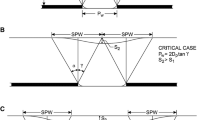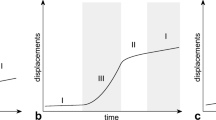Abstract
The characteristics of ground deformation induced by the excavation of underground orebodies are summarized based on an analysis of over 10 years of deformation data recorded in the eastern mining area of the Chengchao mine in China. These data are combined with laws governing the development of ground-surface cracking and collapse to study the corresponding failure mechanism. The results indicate that the ground deformation in most mining-affected areas increases at a low rate of acceleration. Furthermore, the displacement–time curves are exponential in nature (that is, the relationship between displacement and time can be expressed using an exponent). Curves representing the ratio of the horizontal: vertical displacement over time show different behaviors including convergence, fluctuation, increase, fall-back, exponential, and linear trends. The originally designed scope of the ground movement is significantly smaller than the scope of the actual ground movement suggested by the in situ deformation data (the difference in movement angle amounts to 18°; the difference in break angle to 20°). After rapidly decreasing in the initial mining stage, the break angle remained constant (~ 50°) for a long period of time. The surrounding rock mass conformed to a failure model in which the rock mass topples toward the mined-out area leading to failure surfaces being formed in the deep parts of the rock mass. The inclination angles of these failure surfaces are different in different excavation-affected areas. The excavation-affected area in which the failure surfaces occur can be viewed as a large-scale surface-cracking zone. Outside this zone, small-scale surface cracking can be observed and this area can be viewed as a small-scale surface-cracking zone. In the area investigated, the occurrence of ground movement that is significantly larger than predicted is attributed to the combined effect of engineering-geological conditions, hydrogeological conditions, and the burial depth and geometric configuration of the underground orebodies of the mine. More specifically, the surrounding rock mass is continuously subjected to large-scale unloading during the process of karst collapse (during the construction stage) and ground collapse (during the mining stage) of the mine. Then, the surrounding rock mass progressively undergoes toppling failure and becomes unstable, making the region subjected to ground movement progressively extend outwards.




















Similar content being viewed by others
References
Amini M, Ardestani A (2019) Stability analysis of the north-eastern slope of Daralou copper open pit mine against a secondary toppling failure. Eng Geol 249:89–101
Blachowski J, Ellefmo S (2012) Numerical modelling of rock mass deformation in sublevel caving mining system. Acta Geodyn Geomater 9(3):379–388
Brady BHG, Brown ET (2006) Rock mechanics for underground mining. George Allen Unwin, London
Cheng GW, Chen CX, Ma TH, Liu HY, Tang CA (2017) A case study on the strata movement mechanism and surface deformation regulation in Chengchao underground iron mine. Rock Mech Rock Eng 50(4):1011–1032
Cheng GW, Chen CX, Li LC, Zhu WC, Yang TH, Dai F, Ren B (2018) Numerical modelling of strata movement at footwall induced by underground mining. Int J Rock Mech Min Sci 108:142–156
Cui X, Gao Y, Yuan D (2014) Sudden surface collapse disasters caused by shallow partial mining in Datong coalfield, china. Nat Hazards 74(2):911–929
Deng Y, Chen C, **a K, Yang K, Sun C, Zheng X (2018) Investigation on the characteristics of overlying strata caving in the Chengchao iron mine, China. Environ Earth Sci 77(10):362
Deng YY, Chen CX, **a KZ, Pang HS, Sun CY, Yang KY, Zheng XW (2019) Investigation on the distribution characteristics of ground cracks in the Chengchao iron mine, China. Environ Earth Sci 78:280
Ding K, Ma F, Guo J, Zhao H, Lu R, Liu F (2018) Investigation of the mechanism of roof caving in the **chuan Nickel mine, China. Rock Mech Rock Eng 51(4):1215–1226
Edelbro C, Sjöberg J, Malmgren L, Dahnér-Lindqvist C (2012) Prediction and follow-up of failure and fallouts in footwall drifts in the Kiirunavaara mine. Can Geotech J 49(5):546–559
Fu H, Chen CX, **a KZ, Deng YY (2015) Analysis of rock deformation caused by underground mining of metal mines. Chin J Rock Mech Eng 34(9):1859–1868 (in Chinese)
Hamdi P, Stead D, Elmo D, Töyrä J (2018) Use of an integrated finite/discrete element method-discrete fracture network approach to characterize surface subsidence associated with sub-level caving. Int J Rock Mech Min Sci 103:55–67
Hosseini Alaee N, Mozafari A, Mirzaee M, Faghihi A, Tolouei K (2019) Fuzzy evaluation method for the identification of subsidence susceptibility in an underground mine (case study in Tabas coal mine of Iran). Nat Hazards 99:797–806
Hui X, Ma FS, Zhao HJ, Xu JM (2019) Monitoring and statistical analysis of mine subsidence at three metal mines in China. Bull Eng Geol Environ 78:3983–4001
Li X, Wang SJ, Liu TY, Ma FS (2004) Engineering geology, ground surface movement and fissures induced by underground mining in the **chuan Nickel Mine. Eng Geol 76(1–2):93–107
Li WX, Wen L, Liu XM, Hou XB, Liu L (2009) Regional horizontal displacements and its effect on shaft in mining areas. Chin J Rock Mech Eng 28(2):3926–3931 (in Chinese)
Li WX, Wen L, Liu XM (2010) Ground movements caused by deep underground mining in Guan-Zhuang iron mine, Luzhong, China. Int J Appl Earth Obs 12(3):175–182
Li LC, Tang CA, Zhao XD, Cai M (2014) Block caving-induced strata movement and associated surface subsidence: a numerical study based on a demonstration model. Bull Eng Geol Environ 73:1165–1182
Li S, Gao M, Yang X, Zhang R, Ren L, Zhang Z, Li G, Zhang Z, **e J (2018) Numerical simulation of spatial distributions of mining-induced stress and fracture fields for three coal mining layouts. J Rock Mech Geotech Eng 10(5):907–913
Lupo JF (1998) Large-scale surface disturbances resulting from underground mass mining. Int J Rock Mech Min Sci 35(4):399–399
Ma SQ, Chen Y (2017) Application of hydraulic fracturing and energy-absorption rockbolts to improve the stability of a gob-side roadway in a 10-m-thick coal seam: case study. Int J Geomech 17(12):05017002
Ma F, Zhao H, Yuan R, Guo J (2015) Ground movement resulting from underground backfill mining in a nickel mine (Gansu province, China). Nat Hazards 77(3):1475–1490
Malinowska AA, Witkowski WT, Guzy A, Hejmanowski R (2018) Map** ground movements caused by mining-induced earthquakes applying satellite radar interferometry. Eng Geol 246:402–411
Marino G, Osouli A, Elgendy M, Karimpour M (2016) Utilization of historical subsidence data for prediction of adverse subsidence conditions over Trona Mine. Int J Geomech 17(2):04016061
Ng AHM, Ge LL, Yan YG, Li XJ, Chang HC, Zhang K, Rizos C (2010) Map** accumulated mine subsidence using small stack of SAR differential interferograms in the Southern coalfield of New South Wales, Australia. Eng Geol 115(1–2):1–15
Pang HS, Chen CX, **a KZ, Zhang CQ (2020) Study on the methodology for determining the ground acceptable deformation limit in sublevel caving mining based on monitoring data. Chin J Rock Mech Eng 39(4):736–748 (in Chinese)
Rudziński Ł, Mirek K, Mirek J (2019) Rapid ground deformation corresponding to a mining-induced seismic event followed by a massive collapse. Nat Hazards 96:461–471
Sainsbury DP, Sainsbury BL, Lorig LJ (2013) Investigation of caving induced subsidence at the abandoned Grace Mine. Trans Inst Min Metall 119(3):151–161
Santolo ASD, Forte G, Santo A (2018) Analysis of sinkhole triggering mechanisms in the hinterland of Naples (Southern Italy). Eng Geol 237:42–52
Song X, Chen C, **a K, Yang K, Chen S, Liu X (2018) Analysis of the surface deformation characteristics and strata movement mechanism in the main shaft area of chengchao iron mine. Environ Earth Sci 77(9):335
Svartsjaern MA (2019) A prognosis methodology for underground infrastructure damage in sublevel cave mining. Rock Mech Rock Eng 52(1):247–263
Svartsjaern M, Saiang D, Nordlund E, Eitzenberger A (2016) Conceptual numerical modeling of large-scale footwall behavior at the kiirunavaara mine, and implications for deformation monitoring. Rock Mech Rock Eng 49(3):943–960
Villegas T, Nordlund E (2012) Time-dependent movements of the hangingwall at the Kiirunavaara mine. Int J Min Reclam Env 26(2):19–133
Villegas T, Nordlund E, Dahnér-Lindqvist C (2011) Hangingwall surface subsidence at the kiirunavaara mine, Sweden. Eng Geol 121(1–2):18–27
** RS, Chen CX, **ao GF, Huang PL (2011) Study of influence of discontinuities on rock movement and surface deformation in eastern area of Chengchao iron mine. Rock Soil Mech 32(2):532–538 (in Chinese)
**a KZ, Chen CX, Fu H, Pan YC, Deng YY (2016) Mining-induced ground deformation in tectonic stress metal mines: a case study. Eng Geol 210:212–230
**a KZ, Chen CX, Liu XM, Zheng Y, Fu H (2017) Ground movement mechanism in tectonic stress metal mines with steep structure planes. J Cent South Univ 24(9):2092–2104
**a KZ, Chen CX, Zheng Y, Zhang HN, Liu XM, Deng YY, Yang KY (2019) Engineering geology and ground collapse mechanism in the Chengchao Iron-ore Mine in China. Eng Geol 249:129–147
Xu DJ (1998) Study on movement and collapsing angle caused by underground mining in west area of **shandian Iron Mine. Institute of Rock and Soil Mechanics, Chinese Academy of Sciences, Wuhan (in Chinese)
Yin ZR, Zou YF, Deng ZY, Zhang RX (2010) Ground and surface movement rules and parameters in Kailuan mine area. Science Press, Bei**g (in Chinese)
Zhang K, Yang TH, Bai HB, Gamage RP (2018) Longwall mining–induced damage and fractures: field measurements and simulation using FDM and DEM coupled method. Int J Geomech 18(1):04017127
Zhao HJ, Ma FS, Zhang YM, Guo J (2013) Monitoring and analysis of the mining-induced ground movement in the Longshou Mine, China. Rock Mech Rock Eng 46(1):207–211
Zhao TB, Ma SQ, Zhang ZY (2018) Ground control monitoring in backfilled strip mining under the metropolitan district: case study. Int J Geomech 18(7):05018003
Acknowledgements
This work was financially supported by Young Scholar Fund of National Natural Science Foundation of China (Grant Nos. 11602284 and 41602325). The authors are grateful for their continuous support, and also to the authors’ colleagues for their valuable help during this research.
Author information
Authors and Affiliations
Corresponding authors
Ethics declarations
Conflict of interest
The authors declare that they have no conflict of interest.
Additional information
Publisher's Note
Springer Nature remains neutral with regard to jurisdictional claims in published maps and institutional affiliations.
Rights and permissions
About this article
Cite this article
**a, K., Chen, C., Yang, K. et al. A case study on the characteristics of footwall ground deformation and movement and their mechanisms. Nat Hazards 104, 1039–1077 (2020). https://doi.org/10.1007/s11069-020-04204-4
Received:
Accepted:
Published:
Issue Date:
DOI: https://doi.org/10.1007/s11069-020-04204-4




